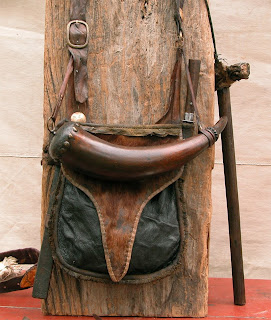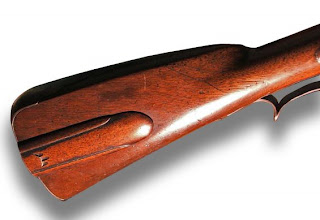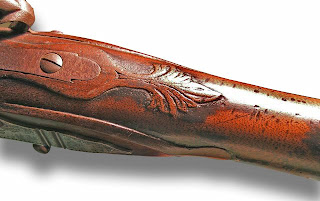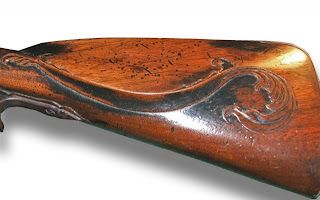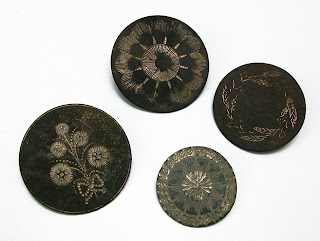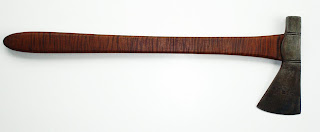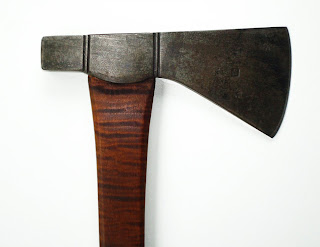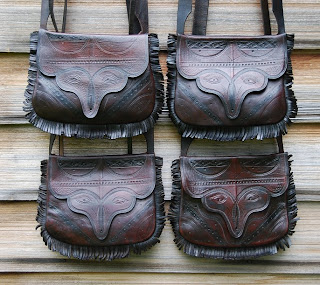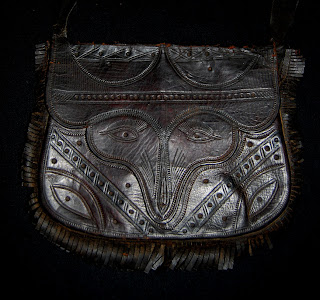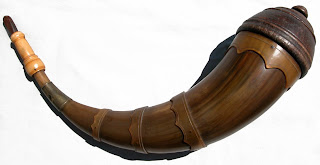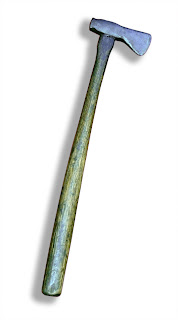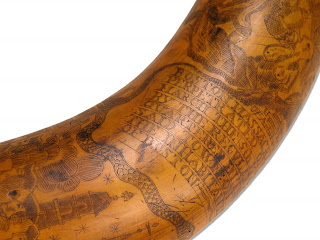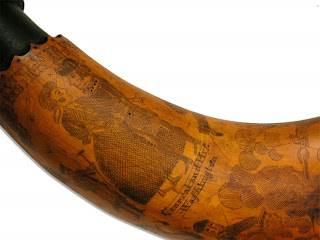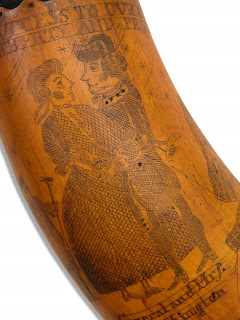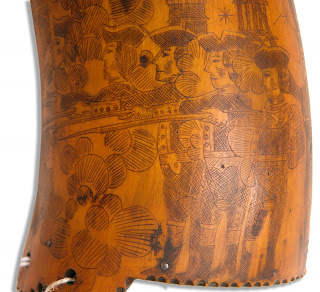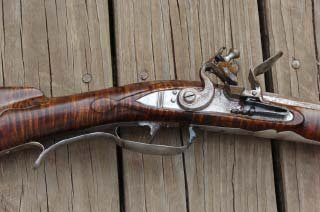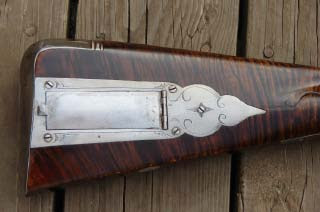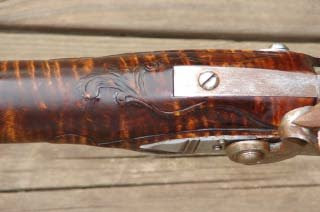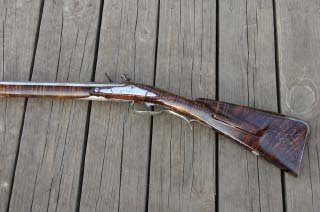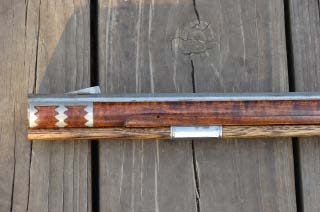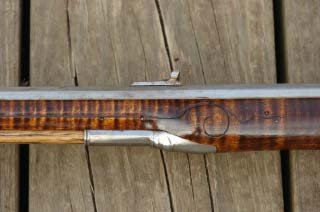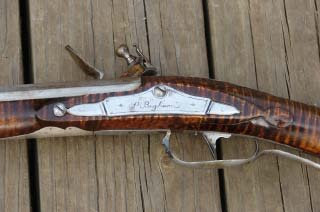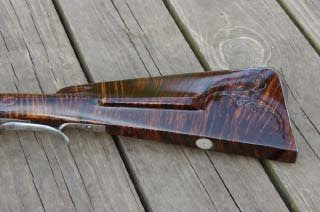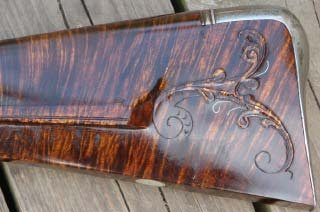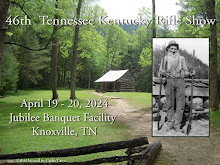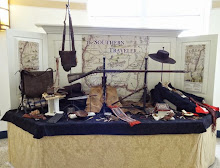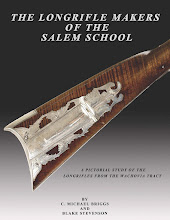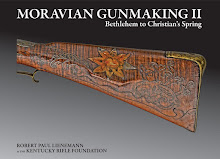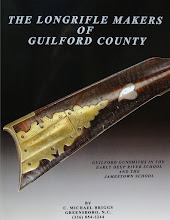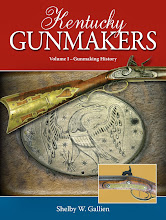Sunday, June 29, 2008
What’s In (Or On) The Bag?
The number of artists and craftspeople devoting their time to reproducing period correct items for use with the Kentucky rifle is staggering. All you need do is take a look at all the names listed on the CLA website or the artists featured in MUZZLELOADER or MUZZLEBLASTS to see an ever increasing group. These talented people make it possible to completely fill the shot pouch with tools for the maintanence of the accompanying firearm as well as items for everyday use in the wilderness.
The effort devoted to these items is amazing. The pieces are well researched and crafted in a manner that matches or exceeds the quality of the originals. Often times the newly made items are more sought after than their original counterparts.
The items accompanying this article are just a small sample of the pieces which are available today. Many of them are one of a kind pieces others lind themselves to duplication. Whichever the case they are all worthy companions for a finely crafted firearm. Whether you actually use them or simply display them in your collection they are an integral part of our early heritage in America.
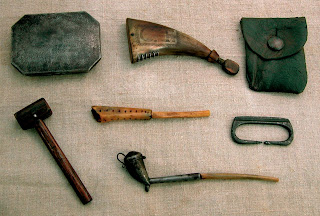 (starting upperleft corner) A flint and steel box by Charles Miller, priming horn by Mark Odle, a small bag used to carry extra flints by Joe Mills, a short starter also by Mills, a turkey call by Charles Norvell, a snake striker by Charles Miller and an iron pipe by Jack Haugh. The lid on the pipe is hinged. The pipe stem is bone.
(starting upperleft corner) A flint and steel box by Charles Miller, priming horn by Mark Odle, a small bag used to carry extra flints by Joe Mills, a short starter also by Mills, a turkey call by Charles Norvell, a snake striker by Charles Miller and an iron pipe by Jack Haugh. The lid on the pipe is hinged. The pipe stem is bone.
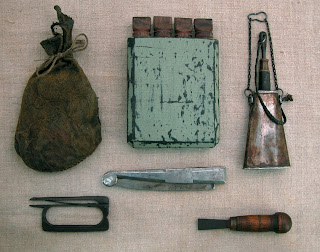 (starting upperleft corner) A shot bag made of bark tanned leather by Joe Mills, a ball container by David Parrish, a priming flask by Gary Birch. The flask is made from tin with abone spout. A folding knife by Kyle Willyard. The all metal knife is a near copy of an original. A snake striker ember tong combination by Charles Miller and a turn screw by Bruce Horne.
(starting upperleft corner) A shot bag made of bark tanned leather by Joe Mills, a ball container by David Parrish, a priming flask by Gary Birch. The flask is made from tin with abone spout. A folding knife by Kyle Willyard. The all metal knife is a near copy of an original. A snake striker ember tong combination by Charles Miller and a turn screw by Bruce Horne.
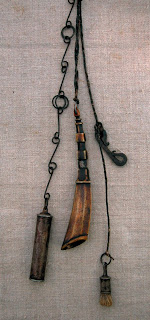 A tin powder measure on a hand made chain, an intricately carved bone measure, miniature striker (that works very well) and a small pan brush all made by Gary Birch. A.R.
A tin powder measure on a hand made chain, an intricately carved bone measure, miniature striker (that works very well) and a small pan brush all made by Gary Birch. A.R.
This article appeared earlier in a CLA publication. We received more comments about this article than any that we have done. We will be doing some additional post on this topic. J.R.
Photos by Jan Riser.
The effort devoted to these items is amazing. The pieces are well researched and crafted in a manner that matches or exceeds the quality of the originals. Often times the newly made items are more sought after than their original counterparts.
The items accompanying this article are just a small sample of the pieces which are available today. Many of them are one of a kind pieces others lind themselves to duplication. Whichever the case they are all worthy companions for a finely crafted firearm. Whether you actually use them or simply display them in your collection they are an integral part of our early heritage in America.
 (starting upperleft corner) A flint and steel box by Charles Miller, priming horn by Mark Odle, a small bag used to carry extra flints by Joe Mills, a short starter also by Mills, a turkey call by Charles Norvell, a snake striker by Charles Miller and an iron pipe by Jack Haugh. The lid on the pipe is hinged. The pipe stem is bone.
(starting upperleft corner) A flint and steel box by Charles Miller, priming horn by Mark Odle, a small bag used to carry extra flints by Joe Mills, a short starter also by Mills, a turkey call by Charles Norvell, a snake striker by Charles Miller and an iron pipe by Jack Haugh. The lid on the pipe is hinged. The pipe stem is bone. (starting upperleft corner) A shot bag made of bark tanned leather by Joe Mills, a ball container by David Parrish, a priming flask by Gary Birch. The flask is made from tin with abone spout. A folding knife by Kyle Willyard. The all metal knife is a near copy of an original. A snake striker ember tong combination by Charles Miller and a turn screw by Bruce Horne.
(starting upperleft corner) A shot bag made of bark tanned leather by Joe Mills, a ball container by David Parrish, a priming flask by Gary Birch. The flask is made from tin with abone spout. A folding knife by Kyle Willyard. The all metal knife is a near copy of an original. A snake striker ember tong combination by Charles Miller and a turn screw by Bruce Horne. A tin powder measure on a hand made chain, an intricately carved bone measure, miniature striker (that works very well) and a small pan brush all made by Gary Birch. A.R.
A tin powder measure on a hand made chain, an intricately carved bone measure, miniature striker (that works very well) and a small pan brush all made by Gary Birch. A.R.This article appeared earlier in a CLA publication. We received more comments about this article than any that we have done. We will be doing some additional post on this topic. J.R.
Photos by Jan Riser.
David Wright
This painting was the winner of the coveted Harrison Eiteljorg Museum (Indianapolis) Purchase Award, 2007 Quest for the West Show. The painting has been added to the museum's permanent collection.
More about David and his work can be found at his web site.
18th Century Colonial Buttons
Saturday, June 28, 2008
Ken Scott
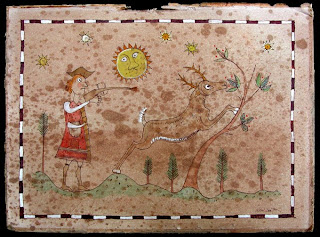
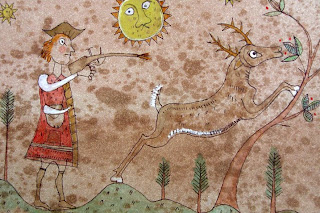 This watercolor painting was was based on the hunter and deer shown on the Hunter Horn, just one of many horns that are in the Mel Hankla “Folksy Artist” exhibit, “Shreds of History – Hung on a Horn”. A horn that was formally in the Jim & Carolyn Dresslar collection. Other horns in the exhibit that feature a hunter and deer are: the E/W Horn, the Roxbury Horn, the Moth Horn, and the Skinner Horn. When I first saw this motif by the “Folksy Artist” several years ago I was intrigued by it and wanted to do a painting of it. I did one for Jim and Carolyn Dresslar. In the past, I have done other paintings with a hunter and deer motif. However, this is only the second painting that I have done based on the work of the “Folksy Artist” horns.K.S.
This watercolor painting was was based on the hunter and deer shown on the Hunter Horn, just one of many horns that are in the Mel Hankla “Folksy Artist” exhibit, “Shreds of History – Hung on a Horn”. A horn that was formally in the Jim & Carolyn Dresslar collection. Other horns in the exhibit that feature a hunter and deer are: the E/W Horn, the Roxbury Horn, the Moth Horn, and the Skinner Horn. When I first saw this motif by the “Folksy Artist” several years ago I was intrigued by it and wanted to do a painting of it. I did one for Jim and Carolyn Dresslar. In the past, I have done other paintings with a hunter and deer motif. However, this is only the second painting that I have done based on the work of the “Folksy Artist” horns.K.S.Ken's work can be seen at his web site.
Thursday, June 26, 2008
Isaac Getz Effigy Pouch with Four Copies by Steven Lalioff
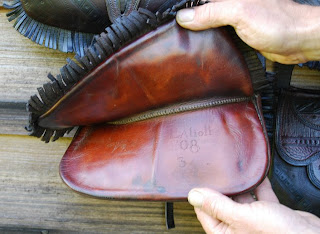
Every great once and awhile, I see a piece of antique leatherwork that excites me as though I were an apprentice again. That old excitement came again last year for me at the CLA show in Lexington when Don Getz showed me his grandfathers hunting bag.
Ever since he was a boy, Don Getz knew that this pouch was the work of his grandfather, Isaac Getz. Isaac was born in 1842 and that according to family history, Isaac made the pouch shortly before leaving for the war in 1863. When Don was a kid, the old pouch hung behind the attic door in the same house built by Isaac in the town of Beaver Springs, Pennsylvania. (On the very peg where Isaac hung it last I wonder?).
I consider the design of this double bag to be the apex of hunting pouch folk-art. When I first examined this bag I realized that the maker, Isaac, must have been trained as a shoemaker due to the exceptional craftsmanship of the construction. According to Getz family history, Isaac was known as a shoe cobbler. Most likely, Isaac was taught by his father, Henry Getz, as he too is recorded as being a shoemaker or repairman. However, the skill and technique evident in this old pouch tells me that Isaac was more than just a cobbler. Evidence that Isaac was trained as a shoe-maker is that each leather piece of the pouch was made by folding the leather in half in order to make the parts symmetrical, no other leather trade used this pattern method to my knowledge. This patternless method also suggests to me that this was the first bag of its kind and not a production design. Also, the embossed decoration of the fox effigy was preformed using embossing wheels and a peg spreading stamp, the very kind of tools used by shoemakers during the mid 19th century. Isaac designed the fox head freehand...and what a good freehand he had.
When reproducing a pouch, it takes a little guess work to match the contour and size of a turned bag. My first attempt to copy this bag was close but off a few degrees, so I adjusted the pattern and now have 3 bags that I feel are close to the original. One bag for Don, one for me and one will be go to the benefit auction next year (2009) at the CLA show in Lexington, in appreciation that such a gathering place has been made for us. S.L.
Photos by Karen Ambercrombie.
Labels:
Isaac Getz,
Steven Lalioff
Wednesday, June 25, 2008
Painted Buffalo Robe by Tom Connin
Paul Bigham
Subscribe to:
Posts (Atom)
